Case Study Report: Persuasion in Business Communication (BUS1003)
VerifiedAdded on 2023/04/22
|8
|1680
|241
Case Study
AI Summary
This case study report examines the critical role of persuasion in business communication. The report begins by defining persuasion and its significance in influencing audience perceptions and behaviors within a business context. It then delves into the rational model of persuasion, emphasizing how individual beliefs and values shape responses to communication. The report identifies key characteristics of persuasive communication, including source credibility, message content, and audience factors. It explores various persuasive strategies, such as ethos, pathos, and logos, and how these are applied in effective business communication. The study uses real-world examples, like Booking.com, to illustrate the practical application of persuasive techniques. Furthermore, the case study explores the use of sales messages, both solicited and unsolicited, and the role of rewards and motivational theories in persuasive communication. The conclusion emphasizes the importance of emotional appeals and relevant information in crafting successful business communications and highlights how these factors contribute to a speaker's effectiveness and credibility.
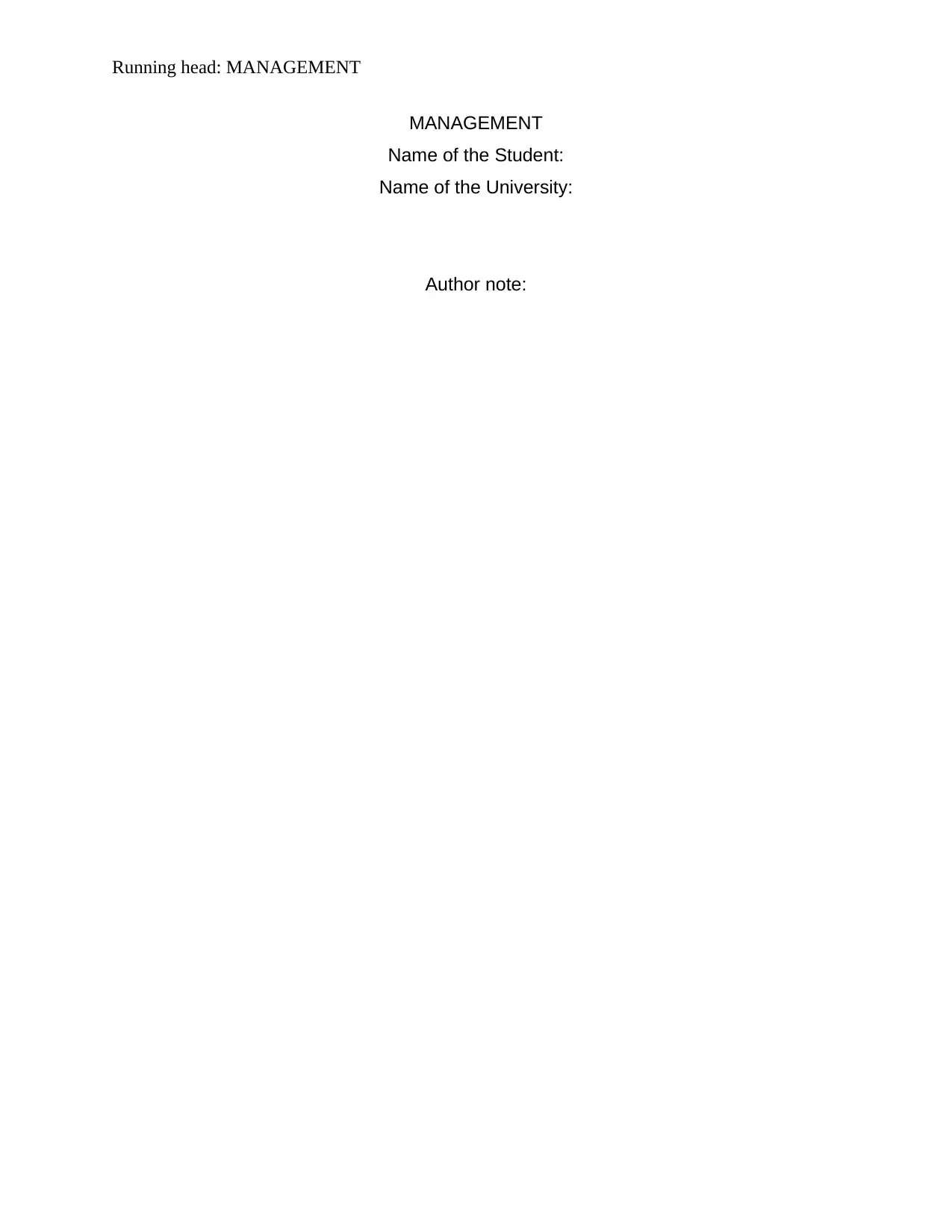
Running head: MANAGEMENT
MANAGEMENT
Name of the Student:
Name of the University:
Author note:
MANAGEMENT
Name of the Student:
Name of the University:
Author note:
Paraphrase This Document
Need a fresh take? Get an instant paraphrase of this document with our AI Paraphraser
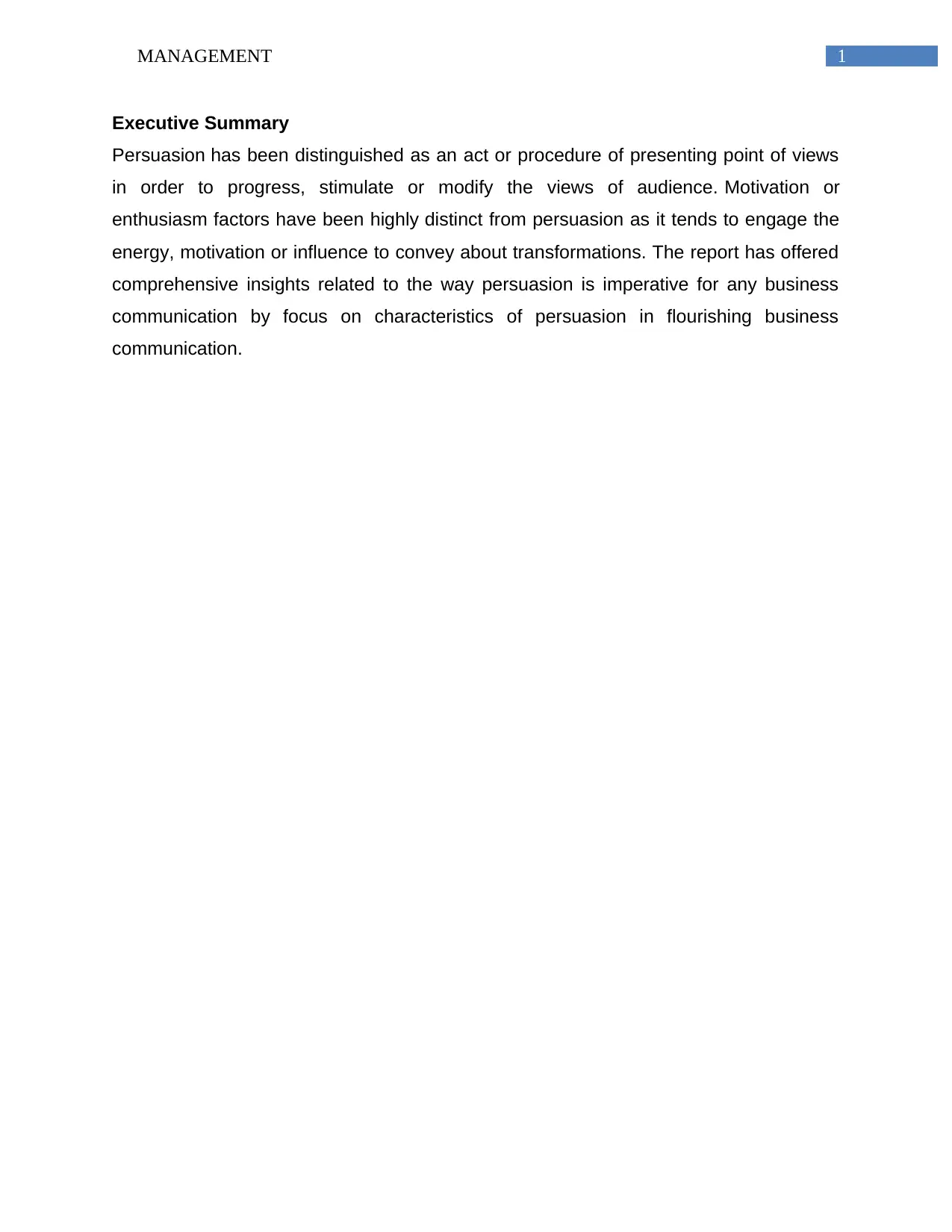
1MANAGEMENT
Executive Summary
Persuasion has been distinguished as an act or procedure of presenting point of views
in order to progress, stimulate or modify the views of audience. Motivation or
enthusiasm factors have been highly distinct from persuasion as it tends to engage the
energy, motivation or influence to convey about transformations. The report has offered
comprehensive insights related to the way persuasion is imperative for any business
communication by focus on characteristics of persuasion in flourishing business
communication.
Executive Summary
Persuasion has been distinguished as an act or procedure of presenting point of views
in order to progress, stimulate or modify the views of audience. Motivation or
enthusiasm factors have been highly distinct from persuasion as it tends to engage the
energy, motivation or influence to convey about transformations. The report has offered
comprehensive insights related to the way persuasion is imperative for any business
communication by focus on characteristics of persuasion in flourishing business
communication.
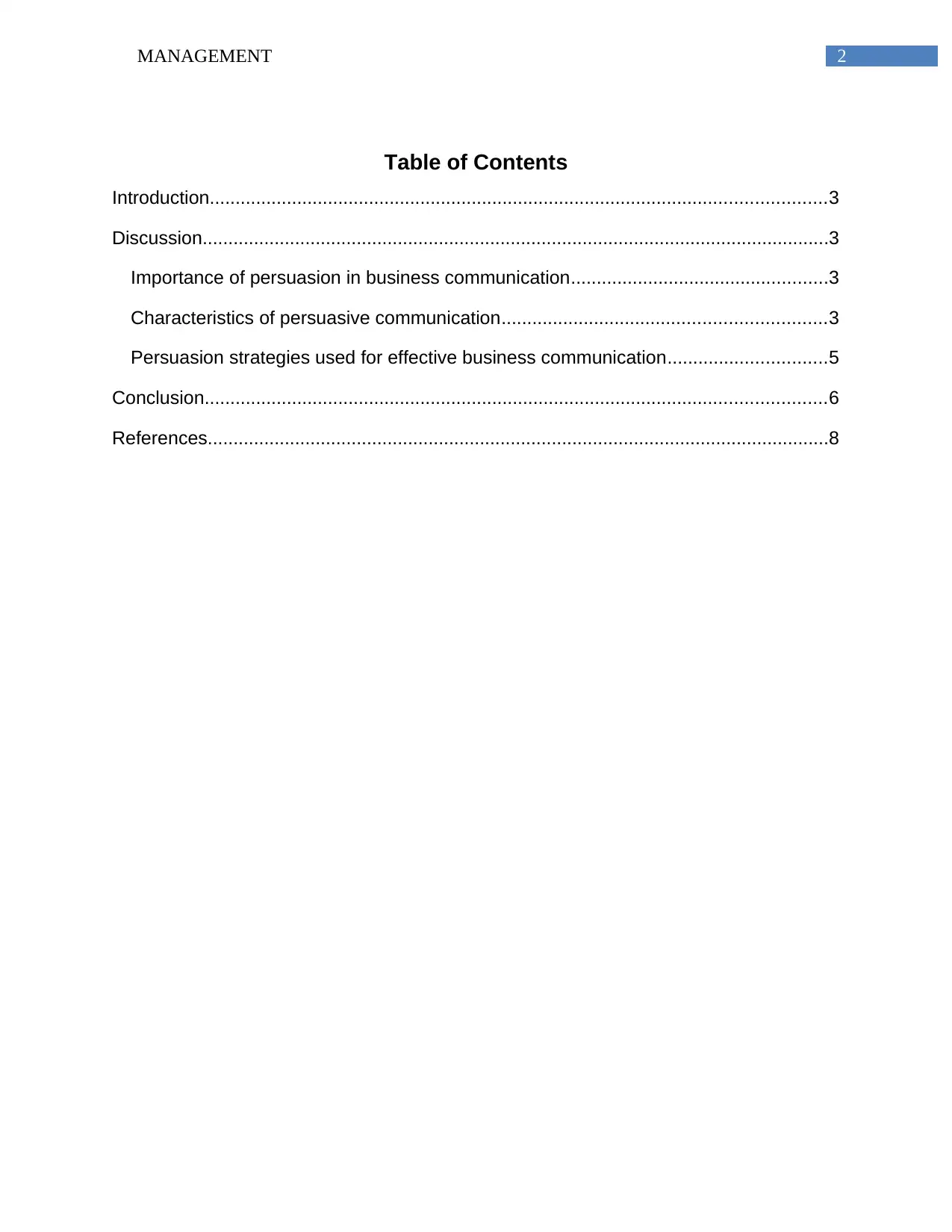
2MANAGEMENT
Table of Contents
Introduction........................................................................................................................3
Discussion..........................................................................................................................3
Importance of persuasion in business communication..................................................3
Characteristics of persuasive communication...............................................................3
Persuasion strategies used for effective business communication...............................5
Conclusion.........................................................................................................................6
References.........................................................................................................................8
Table of Contents
Introduction........................................................................................................................3
Discussion..........................................................................................................................3
Importance of persuasion in business communication..................................................3
Characteristics of persuasive communication...............................................................3
Persuasion strategies used for effective business communication...............................5
Conclusion.........................................................................................................................6
References.........................................................................................................................8
⊘ This is a preview!⊘
Do you want full access?
Subscribe today to unlock all pages.

Trusted by 1+ million students worldwide
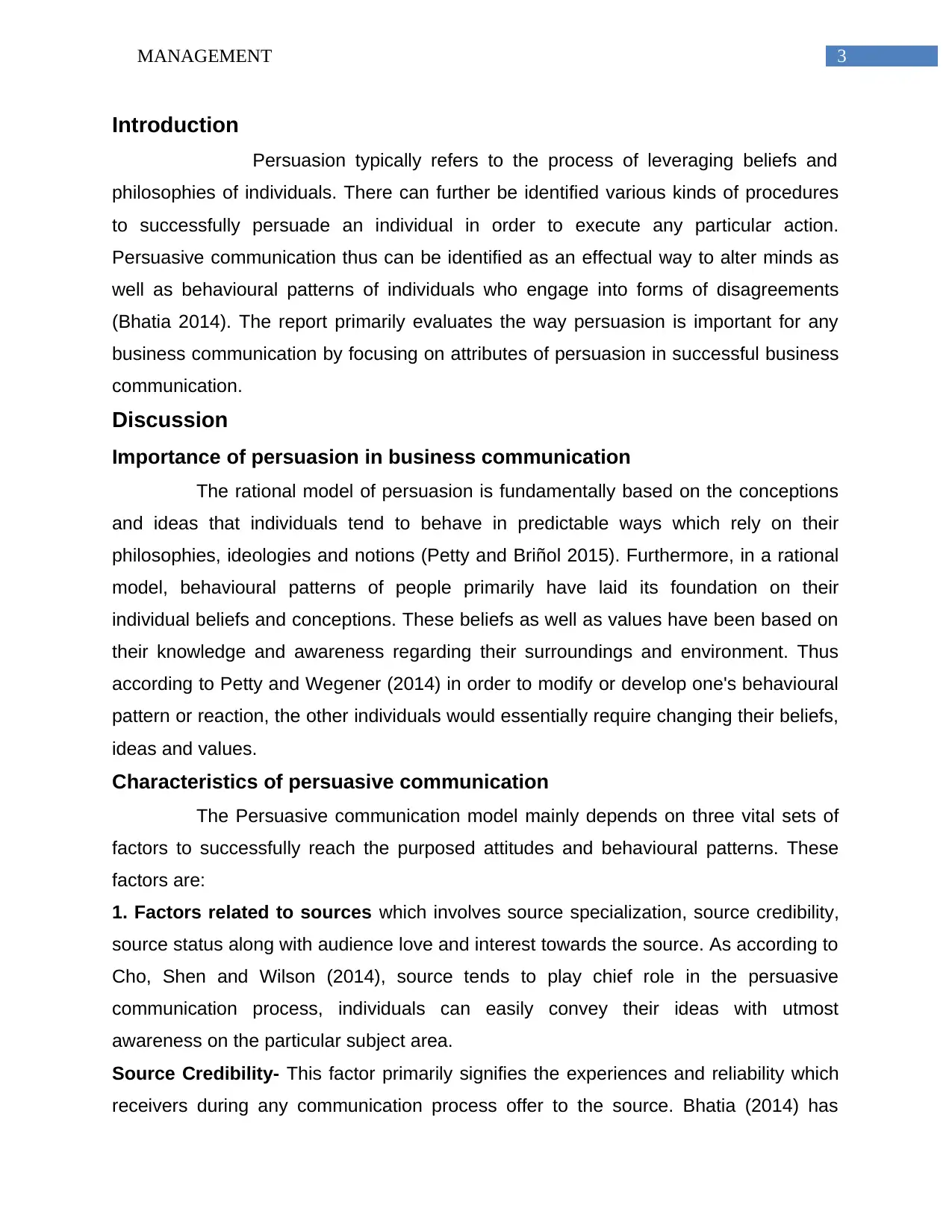
3MANAGEMENT
Introduction
Persuasion typically refers to the process of leveraging beliefs and
philosophies of individuals. There can further be identified various kinds of procedures
to successfully persuade an individual in order to execute any particular action.
Persuasive communication thus can be identified as an effectual way to alter minds as
well as behavioural patterns of individuals who engage into forms of disagreements
(Bhatia 2014). The report primarily evaluates the way persuasion is important for any
business communication by focusing on attributes of persuasion in successful business
communication.
Discussion
Importance of persuasion in business communication
The rational model of persuasion is fundamentally based on the conceptions
and ideas that individuals tend to behave in predictable ways which rely on their
philosophies, ideologies and notions (Petty and Briñol 2015). Furthermore, in a rational
model, behavioural patterns of people primarily have laid its foundation on their
individual beliefs and conceptions. These beliefs as well as values have been based on
their knowledge and awareness regarding their surroundings and environment. Thus
according to Petty and Wegener (2014) in order to modify or develop one's behavioural
pattern or reaction, the other individuals would essentially require changing their beliefs,
ideas and values.
Characteristics of persuasive communication
The Persuasive communication model mainly depends on three vital sets of
factors to successfully reach the purposed attitudes and behavioural patterns. These
factors are:
1. Factors related to sources which involves source specialization, source credibility,
source status along with audience love and interest towards the source. As according to
Cho, Shen and Wilson (2014), source tends to play chief role in the persuasive
communication process, individuals can easily convey their ideas with utmost
awareness on the particular subject area.
Source Credibility- This factor primarily signifies the experiences and reliability which
receivers during any communication process offer to the source. Bhatia (2014) has
Introduction
Persuasion typically refers to the process of leveraging beliefs and
philosophies of individuals. There can further be identified various kinds of procedures
to successfully persuade an individual in order to execute any particular action.
Persuasive communication thus can be identified as an effectual way to alter minds as
well as behavioural patterns of individuals who engage into forms of disagreements
(Bhatia 2014). The report primarily evaluates the way persuasion is important for any
business communication by focusing on attributes of persuasion in successful business
communication.
Discussion
Importance of persuasion in business communication
The rational model of persuasion is fundamentally based on the conceptions
and ideas that individuals tend to behave in predictable ways which rely on their
philosophies, ideologies and notions (Petty and Briñol 2015). Furthermore, in a rational
model, behavioural patterns of people primarily have laid its foundation on their
individual beliefs and conceptions. These beliefs as well as values have been based on
their knowledge and awareness regarding their surroundings and environment. Thus
according to Petty and Wegener (2014) in order to modify or develop one's behavioural
pattern or reaction, the other individuals would essentially require changing their beliefs,
ideas and values.
Characteristics of persuasive communication
The Persuasive communication model mainly depends on three vital sets of
factors to successfully reach the purposed attitudes and behavioural patterns. These
factors are:
1. Factors related to sources which involves source specialization, source credibility,
source status along with audience love and interest towards the source. As according to
Cho, Shen and Wilson (2014), source tends to play chief role in the persuasive
communication process, individuals can easily convey their ideas with utmost
awareness on the particular subject area.
Source Credibility- This factor primarily signifies the experiences and reliability which
receivers during any communication process offer to the source. Bhatia (2014) has
Paraphrase This Document
Need a fresh take? Get an instant paraphrase of this document with our AI Paraphraser
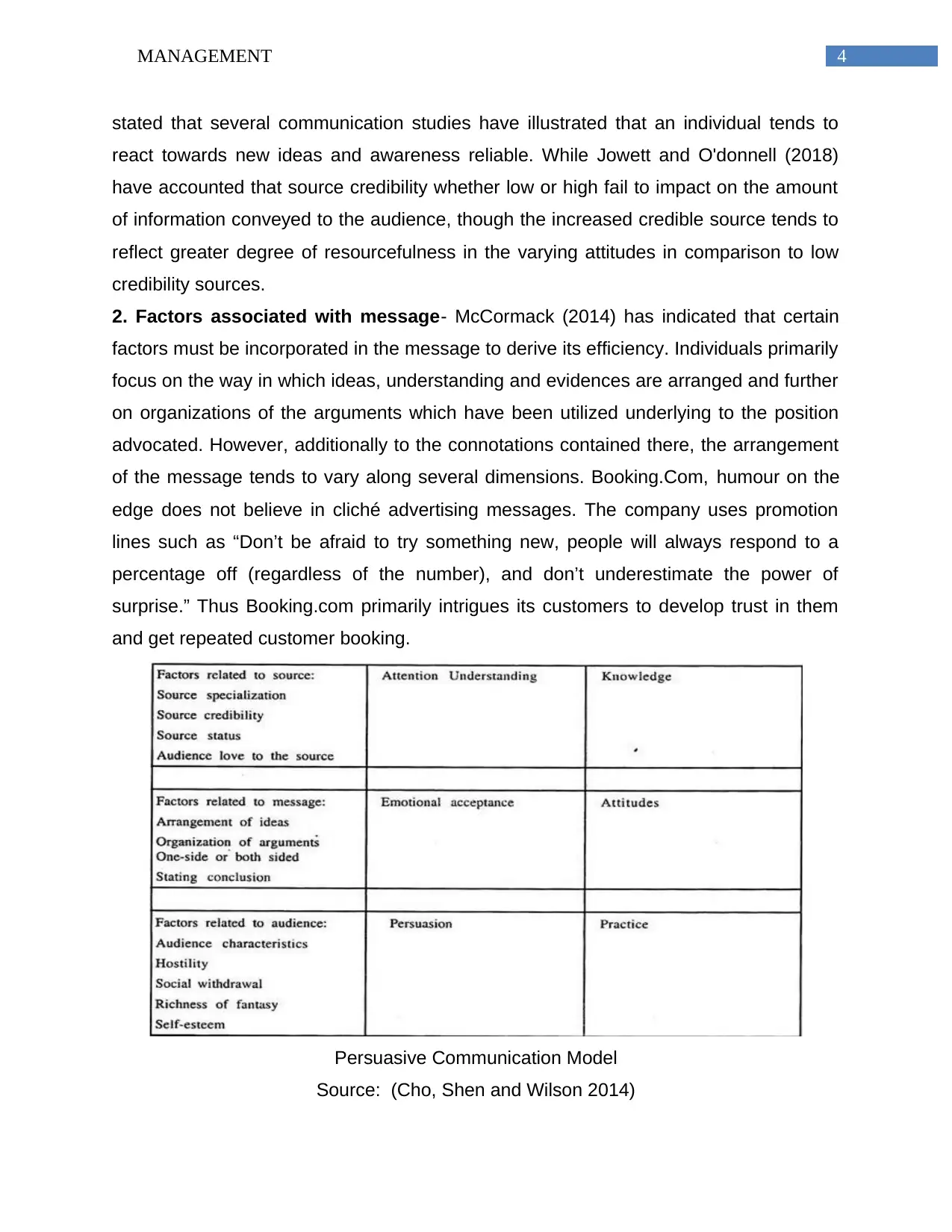
4MANAGEMENT
stated that several communication studies have illustrated that an individual tends to
react towards new ideas and awareness reliable. While Jowett and O'donnell (2018)
have accounted that source credibility whether low or high fail to impact on the amount
of information conveyed to the audience, though the increased credible source tends to
reflect greater degree of resourcefulness in the varying attitudes in comparison to low
credibility sources.
2. Factors associated with message- McCormack (2014) has indicated that certain
factors must be incorporated in the message to derive its efficiency. Individuals primarily
focus on the way in which ideas, understanding and evidences are arranged and further
on organizations of the arguments which have been utilized underlying to the position
advocated. However, additionally to the connotations contained there, the arrangement
of the message tends to vary along several dimensions. Booking.Com, humour on the
edge does not believe in cliché advertising messages. The company uses promotion
lines such as “Don’t be afraid to try something new, people will always respond to a
percentage off (regardless of the number), and don’t underestimate the power of
surprise.” Thus Booking.com primarily intrigues its customers to develop trust in them
and get repeated customer booking.
Persuasive Communication Model
Source: (Cho, Shen and Wilson 2014)
stated that several communication studies have illustrated that an individual tends to
react towards new ideas and awareness reliable. While Jowett and O'donnell (2018)
have accounted that source credibility whether low or high fail to impact on the amount
of information conveyed to the audience, though the increased credible source tends to
reflect greater degree of resourcefulness in the varying attitudes in comparison to low
credibility sources.
2. Factors associated with message- McCormack (2014) has indicated that certain
factors must be incorporated in the message to derive its efficiency. Individuals primarily
focus on the way in which ideas, understanding and evidences are arranged and further
on organizations of the arguments which have been utilized underlying to the position
advocated. However, additionally to the connotations contained there, the arrangement
of the message tends to vary along several dimensions. Booking.Com, humour on the
edge does not believe in cliché advertising messages. The company uses promotion
lines such as “Don’t be afraid to try something new, people will always respond to a
percentage off (regardless of the number), and don’t underestimate the power of
surprise.” Thus Booking.com primarily intrigues its customers to develop trust in them
and get repeated customer booking.
Persuasive Communication Model
Source: (Cho, Shen and Wilson 2014)
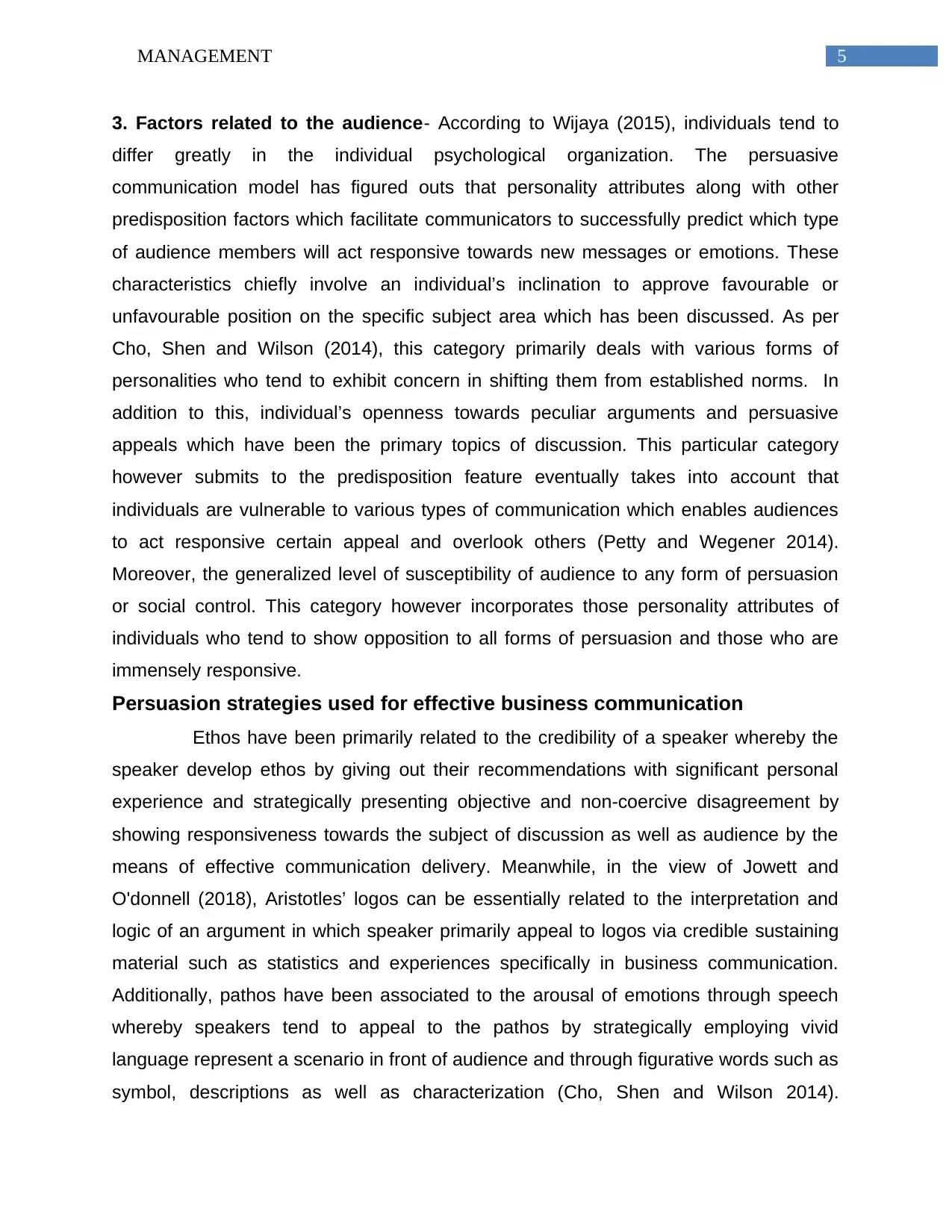
5MANAGEMENT
3. Factors related to the audience- According to Wijaya (2015), individuals tend to
differ greatly in the individual psychological organization. The persuasive
communication model has figured outs that personality attributes along with other
predisposition factors which facilitate communicators to successfully predict which type
of audience members will act responsive towards new messages or emotions. These
characteristics chiefly involve an individual’s inclination to approve favourable or
unfavourable position on the specific subject area which has been discussed. As per
Cho, Shen and Wilson (2014), this category primarily deals with various forms of
personalities who tend to exhibit concern in shifting them from established norms. In
addition to this, individual’s openness towards peculiar arguments and persuasive
appeals which have been the primary topics of discussion. This particular category
however submits to the predisposition feature eventually takes into account that
individuals are vulnerable to various types of communication which enables audiences
to act responsive certain appeal and overlook others (Petty and Wegener 2014).
Moreover, the generalized level of susceptibility of audience to any form of persuasion
or social control. This category however incorporates those personality attributes of
individuals who tend to show opposition to all forms of persuasion and those who are
immensely responsive.
Persuasion strategies used for effective business communication
Ethos have been primarily related to the credibility of a speaker whereby the
speaker develop ethos by giving out their recommendations with significant personal
experience and strategically presenting objective and non-coercive disagreement by
showing responsiveness towards the subject of discussion as well as audience by the
means of effective communication delivery. Meanwhile, in the view of Jowett and
O'donnell (2018), Aristotles’ logos can be essentially related to the interpretation and
logic of an argument in which speaker primarily appeal to logos via credible sustaining
material such as statistics and experiences specifically in business communication.
Additionally, pathos have been associated to the arousal of emotions through speech
whereby speakers tend to appeal to the pathos by strategically employing vivid
language represent a scenario in front of audience and through figurative words such as
symbol, descriptions as well as characterization (Cho, Shen and Wilson 2014).
3. Factors related to the audience- According to Wijaya (2015), individuals tend to
differ greatly in the individual psychological organization. The persuasive
communication model has figured outs that personality attributes along with other
predisposition factors which facilitate communicators to successfully predict which type
of audience members will act responsive towards new messages or emotions. These
characteristics chiefly involve an individual’s inclination to approve favourable or
unfavourable position on the specific subject area which has been discussed. As per
Cho, Shen and Wilson (2014), this category primarily deals with various forms of
personalities who tend to exhibit concern in shifting them from established norms. In
addition to this, individual’s openness towards peculiar arguments and persuasive
appeals which have been the primary topics of discussion. This particular category
however submits to the predisposition feature eventually takes into account that
individuals are vulnerable to various types of communication which enables audiences
to act responsive certain appeal and overlook others (Petty and Wegener 2014).
Moreover, the generalized level of susceptibility of audience to any form of persuasion
or social control. This category however incorporates those personality attributes of
individuals who tend to show opposition to all forms of persuasion and those who are
immensely responsive.
Persuasion strategies used for effective business communication
Ethos have been primarily related to the credibility of a speaker whereby the
speaker develop ethos by giving out their recommendations with significant personal
experience and strategically presenting objective and non-coercive disagreement by
showing responsiveness towards the subject of discussion as well as audience by the
means of effective communication delivery. Meanwhile, in the view of Jowett and
O'donnell (2018), Aristotles’ logos can be essentially related to the interpretation and
logic of an argument in which speaker primarily appeal to logos via credible sustaining
material such as statistics and experiences specifically in business communication.
Additionally, pathos have been associated to the arousal of emotions through speech
whereby speakers tend to appeal to the pathos by strategically employing vivid
language represent a scenario in front of audience and through figurative words such as
symbol, descriptions as well as characterization (Cho, Shen and Wilson 2014).
⊘ This is a preview!⊘
Do you want full access?
Subscribe today to unlock all pages.

Trusted by 1+ million students worldwide
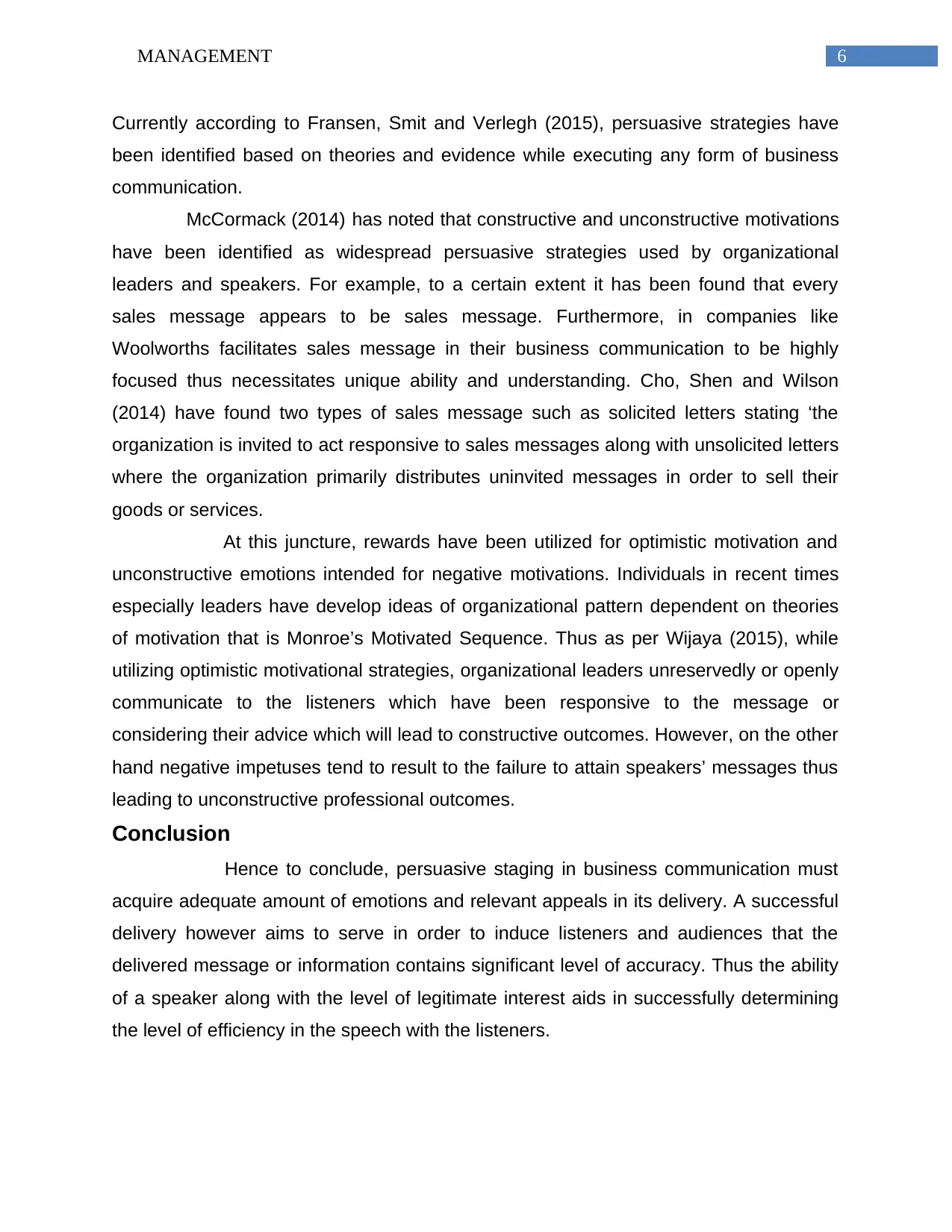
6MANAGEMENT
Currently according to Fransen, Smit and Verlegh (2015), persuasive strategies have
been identified based on theories and evidence while executing any form of business
communication.
McCormack (2014) has noted that constructive and unconstructive motivations
have been identified as widespread persuasive strategies used by organizational
leaders and speakers. For example, to a certain extent it has been found that every
sales message appears to be sales message. Furthermore, in companies like
Woolworths facilitates sales message in their business communication to be highly
focused thus necessitates unique ability and understanding. Cho, Shen and Wilson
(2014) have found two types of sales message such as solicited letters stating ‘the
organization is invited to act responsive to sales messages along with unsolicited letters
where the organization primarily distributes uninvited messages in order to sell their
goods or services.
At this juncture, rewards have been utilized for optimistic motivation and
unconstructive emotions intended for negative motivations. Individuals in recent times
especially leaders have develop ideas of organizational pattern dependent on theories
of motivation that is Monroe’s Motivated Sequence. Thus as per Wijaya (2015), while
utilizing optimistic motivational strategies, organizational leaders unreservedly or openly
communicate to the listeners which have been responsive to the message or
considering their advice which will lead to constructive outcomes. However, on the other
hand negative impetuses tend to result to the failure to attain speakers’ messages thus
leading to unconstructive professional outcomes.
Conclusion
Hence to conclude, persuasive staging in business communication must
acquire adequate amount of emotions and relevant appeals in its delivery. A successful
delivery however aims to serve in order to induce listeners and audiences that the
delivered message or information contains significant level of accuracy. Thus the ability
of a speaker along with the level of legitimate interest aids in successfully determining
the level of efficiency in the speech with the listeners.
Currently according to Fransen, Smit and Verlegh (2015), persuasive strategies have
been identified based on theories and evidence while executing any form of business
communication.
McCormack (2014) has noted that constructive and unconstructive motivations
have been identified as widespread persuasive strategies used by organizational
leaders and speakers. For example, to a certain extent it has been found that every
sales message appears to be sales message. Furthermore, in companies like
Woolworths facilitates sales message in their business communication to be highly
focused thus necessitates unique ability and understanding. Cho, Shen and Wilson
(2014) have found two types of sales message such as solicited letters stating ‘the
organization is invited to act responsive to sales messages along with unsolicited letters
where the organization primarily distributes uninvited messages in order to sell their
goods or services.
At this juncture, rewards have been utilized for optimistic motivation and
unconstructive emotions intended for negative motivations. Individuals in recent times
especially leaders have develop ideas of organizational pattern dependent on theories
of motivation that is Monroe’s Motivated Sequence. Thus as per Wijaya (2015), while
utilizing optimistic motivational strategies, organizational leaders unreservedly or openly
communicate to the listeners which have been responsive to the message or
considering their advice which will lead to constructive outcomes. However, on the other
hand negative impetuses tend to result to the failure to attain speakers’ messages thus
leading to unconstructive professional outcomes.
Conclusion
Hence to conclude, persuasive staging in business communication must
acquire adequate amount of emotions and relevant appeals in its delivery. A successful
delivery however aims to serve in order to induce listeners and audiences that the
delivered message or information contains significant level of accuracy. Thus the ability
of a speaker along with the level of legitimate interest aids in successfully determining
the level of efficiency in the speech with the listeners.
Paraphrase This Document
Need a fresh take? Get an instant paraphrase of this document with our AI Paraphraser
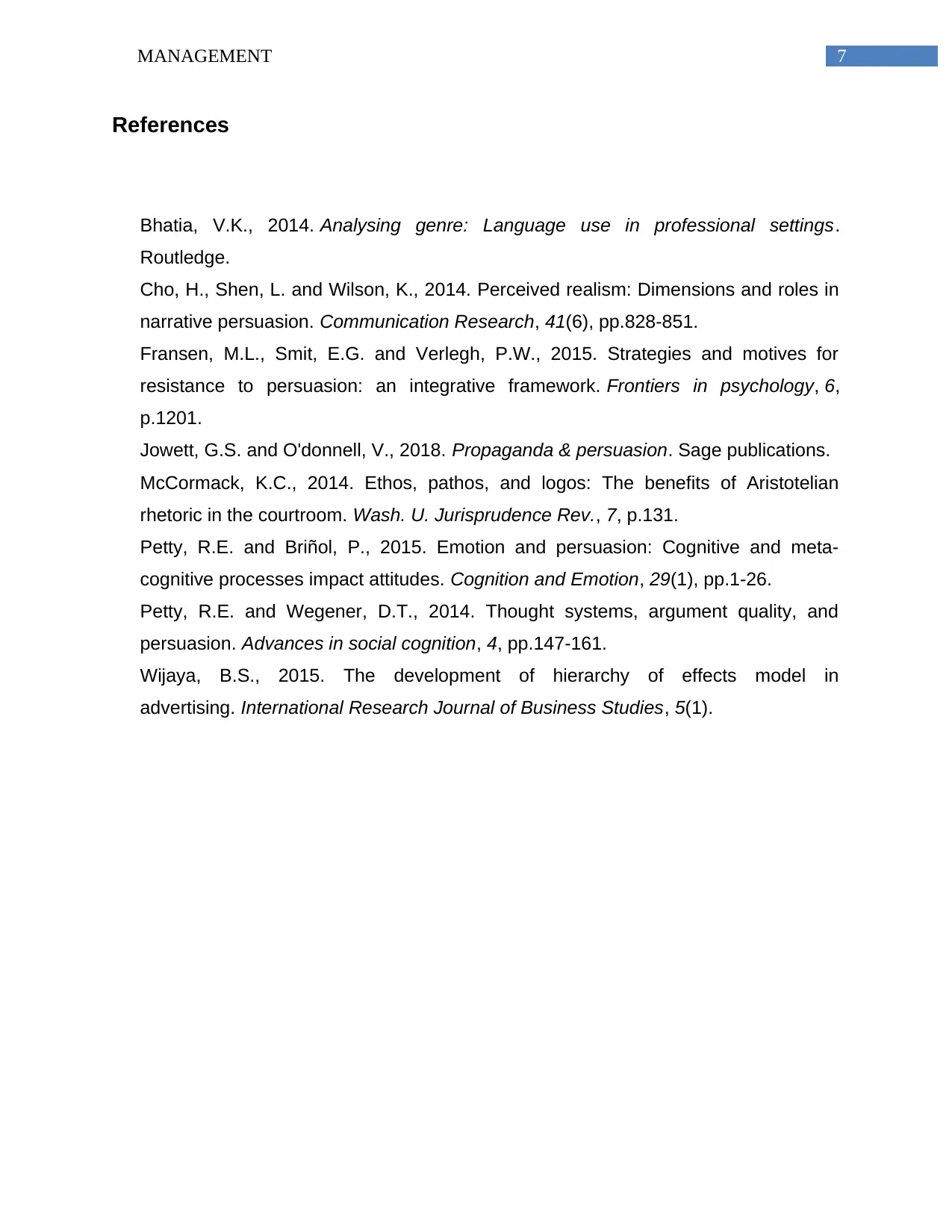
7MANAGEMENT
References
Bhatia, V.K., 2014. Analysing genre: Language use in professional settings.
Routledge.
Cho, H., Shen, L. and Wilson, K., 2014. Perceived realism: Dimensions and roles in
narrative persuasion. Communication Research, 41(6), pp.828-851.
Fransen, M.L., Smit, E.G. and Verlegh, P.W., 2015. Strategies and motives for
resistance to persuasion: an integrative framework. Frontiers in psychology, 6,
p.1201.
Jowett, G.S. and O'donnell, V., 2018. Propaganda & persuasion. Sage publications.
McCormack, K.C., 2014. Ethos, pathos, and logos: The benefits of Aristotelian
rhetoric in the courtroom. Wash. U. Jurisprudence Rev., 7, p.131.
Petty, R.E. and Briñol, P., 2015. Emotion and persuasion: Cognitive and meta-
cognitive processes impact attitudes. Cognition and Emotion, 29(1), pp.1-26.
Petty, R.E. and Wegener, D.T., 2014. Thought systems, argument quality, and
persuasion. Advances in social cognition, 4, pp.147-161.
Wijaya, B.S., 2015. The development of hierarchy of effects model in
advertising. International Research Journal of Business Studies, 5(1).
References
Bhatia, V.K., 2014. Analysing genre: Language use in professional settings.
Routledge.
Cho, H., Shen, L. and Wilson, K., 2014. Perceived realism: Dimensions and roles in
narrative persuasion. Communication Research, 41(6), pp.828-851.
Fransen, M.L., Smit, E.G. and Verlegh, P.W., 2015. Strategies and motives for
resistance to persuasion: an integrative framework. Frontiers in psychology, 6,
p.1201.
Jowett, G.S. and O'donnell, V., 2018. Propaganda & persuasion. Sage publications.
McCormack, K.C., 2014. Ethos, pathos, and logos: The benefits of Aristotelian
rhetoric in the courtroom. Wash. U. Jurisprudence Rev., 7, p.131.
Petty, R.E. and Briñol, P., 2015. Emotion and persuasion: Cognitive and meta-
cognitive processes impact attitudes. Cognition and Emotion, 29(1), pp.1-26.
Petty, R.E. and Wegener, D.T., 2014. Thought systems, argument quality, and
persuasion. Advances in social cognition, 4, pp.147-161.
Wijaya, B.S., 2015. The development of hierarchy of effects model in
advertising. International Research Journal of Business Studies, 5(1).
1 out of 8
Related Documents
Your All-in-One AI-Powered Toolkit for Academic Success.
+13062052269
info@desklib.com
Available 24*7 on WhatsApp / Email
![[object Object]](/_next/static/media/star-bottom.7253800d.svg)
Unlock your academic potential
Copyright © 2020–2025 A2Z Services. All Rights Reserved. Developed and managed by ZUCOL.




